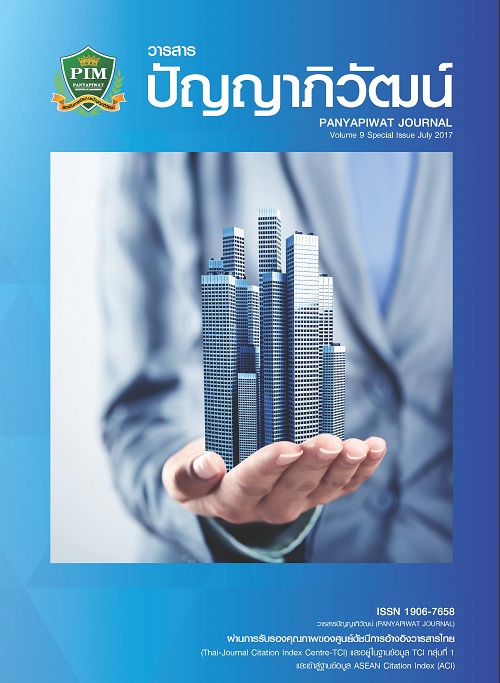ต้นทุนและมูลค่าเพิ่มของผลิตภัณฑ์อาหารและเครื่องดื่มจากว่านหางจระเข้
Main Article Content
บทคัดย่อ
งานวิจัยนี้เป็นการวิจัยเชิงปฏิบัติการแบบมีส่วนร่วมกับชุมชน มีวัตถุประสงค์เพื่อศึกษาต้นทุนและมูลค่าเพิ่มของผลิตภัณฑ์อาหารและเครื่องดื่มจากว่านหางจระเข้ เมื่อเปรียบเทียบกับการส่งว่านหางจระเข้สดส่งโรงงานของเกษตรกร โดยทำการศึกษาผลิตภัณฑ์อาหารและเครื่องดื่มจากว่านหางจระเข้ จำนวน 20 รายการที่ผ่านการประเมินคุณภาพอาหารทางประสาทสัมผัสด้วยแบบทดสอบความชอบ 9-point hedonic scale และการสอบถามความพึงพอใจและการยอมรับผลิตภัณฑ์ของผู้บริโภคจำนวน 2,000 คน วิเคราะห์ข้อมูลโดยใช้ทั้งสถิติเชิงพรรณนา ได้แก่ ร้อยละ ค่าเฉลี่ย และส่วนเบี่ยงเบนมาตรฐาน
ผลการวิจัยพบว่า ต้นทุนการผลิตของผลิตภัณฑ์อาหารและเครื่องดื่มจากว่านหางจระเข้โดยใช้ว่านหางจระเข้สด จำนวน 1 กิโลกรัม เมื่อนำมาแปรรูปเป็นดังนี้ แยมว่านหางจระเข้-สับปะรดมีต้นทุนรวมมากที่สุดคือ 172.25 บาท รองลงมา ได้แก่ แยมว่านหางจระเข้-มะม่วงหาว (169.41 บาท) และไอศกรีมกะทิว่านหางจระเข้ (143.97 บาท) ส่วนผลิตภัณฑ์ที่มีต้นทุนรวมต่ำที่สุดคือ ว่านหางจระเข้ลอยแก้วอัญชัน-มะนาว คือ 25.92 บาท รองลงมา ได้แก่ ว่านหางจระเข้ลอยแก้วตะไคร้-ใบเตย (30.09 บาท) และว่านหางจระเข้ในน้ำลีลาวดี (33.41 บาท) และผลการศึกษามูลค่าที่เพิ่มขึ้นของผลิตภัณฑ์ว่านหางจระเข้ พบว่า แยมว่านหางจระเข้-มะม่วงหาวมีมูลค่าเพิ่มมากที่สุด เฉลี่ยกิโลกรัมละ 220.58 บาท รองลงมา ได้แก่ แยมว่านหางจระเข้-สับปะรดมีมูลค่าเพิ่มเฉลี่ยกิโลกรัมละ 217.74 บาท และซอร์เบทว่านหางจระเข้-โหระพา มีมูลค่าเพิ่มเฉลี่ยกิโลกรัมละ 143.56 บาท ส่วนผลิตภัณฑ์ที่มีมูลค่าเพิ่มต่ำที่สุดคือ ท็อฟฟี่ว่านหางจระเข้ โดยมีมูลค่าเพิ่มเฉลี่ยกิโลกรัมละ 19.50 บาท
This participatory action research in community aims to study cost and value added of food product and beverage from aloe vera after comparing with shipment to the factory of agriculturists. Twenty products from aloe vera were evaluated by sensory evaluation of food by 9- point hedonic scale and questionnaire, the satisfaction, opinion and acceptance of product from 2,000 consumers were tested. The data were analyzed by using descriptive statistics of percentage, mean and standard deviation.
The research found that cost of food product and beverage from 1 kg. aloe vera after processing were: aloe vera and pineapple jam had the highest cost of 205.59 baht, aloe vera and Karonda jam (169.41 baht) and aloe vera ice cream (143.97 baht). The lowest cost was aloe vera in syrup with butterfly pea and lime of 25.92 baht, aloe vera in syrup with lemongrass and pandan leaves (30.09 baht) and aloe vera in syrup with Plumeria (33.41 baht) respectively. The study of the value added found that aloe vera and Karonda jam had the most value added at average 220.58 baht per kilogram, aloe vera and pineapple had value added at average 217.74 per kilogram and sorbet aloe vera and basil had value added at 143.56 baht per kilogram and the least value added was aloe vera candy which was 19.50 baht per kilogram.
Article Details
“ข้าพเจ้าและผู้เขียนร่วม (ถ้ามี) ขอรับรองว่า บทความที่เสนอมานี้ยังไม่เคยได้รับการตีพิมพ์และไม่ได้อยู่ระหว่างกระบวนการพิจารณาลงตีพิมพ์ในวารสารหรือแหล่งเผยแพร่อื่นใด ข้าพเจ้าและผู้เขียนร่วมยอมรับหลักเกณฑ์การพิจารณาต้นฉบับ ทั้งยินยอมให้กองบรรณาธิการมีสิทธิ์พิจารณาและตรวจแก้ต้นฉบับได้ตามที่เห็นสมควร พร้อมนี้ขอมอบลิขสิทธิ์บทความที่ได้รับการตีพิมพ์ให้แก่สถาบันการจัดการปัญญาภิวัฒน์หากมีการฟ้องร้องเรื่องการละเมิดลิขสิทธิ์เกี่ยวกับภาพ กราฟ ข้อความส่วนใดส่วนหนึ่งและ/หรือข้อคิดเห็นที่ปรากฏในบทความข้าพเจ้าและผู้เขียนร่วมยินยอมรับผิดชอบแต่เพียงฝ่ายเดียว”
เอกสารอ้างอิง
Ahlawat, K. S. & Khatkar, B. S. (2011). Processing, food applications and safety of aloe vera product: a review. J Food Sci Technol, 48(5), 525-533.
Boonthai, W. & Phoungchandang, S. (2012). Evaluation of Physical and Chemical Properties of Aloe barbadensis Miller. Agricultural Sci. J., 43(3), 308-310. [in Thai]
Energy Policy and Planning Office, Ministry of Energy. (n.d.). LPG gas fuel for cooking. Retrieved June 20, 2015, from https://www2.eppo.go.th/encon/ebook/AW_LPG-OK.pdf [in Thai]
Hua Hin District Agricultural Office. (2015). Report on the Situation crops grown in the district in 2014. (Mimeographed). [in Thai]
Ministry of Labour. (2015). Rights under labor law. Retrieved September 7, 2015, from https://www.mol.go.th/employee/rihgt_labor%20low [in Thai]
Office of agricultural economics, Ministry of agriculture and cooperatives. (2007). Thailand’s herbs economic year 2005/2006: Case study of Aloe Vera. Paniculata and Cussumanar Ginger.Bureau of agriculture economic research. [in Thai]
Pulldee, M. (2008). Managerial accounting (2nd ed.). Bangkok: Triple Education. [in Thai]
Sakvikrom, P. (2008). Value Added and Adds Cost. Retrieved December 20, 2012, from https://www.l3nr.org/posts/181838 [in Thai]
Sannamwong, P. (2011). The added value of Sericulture. Retrieved January 16, 2015, from https://www.gotoknow.org/posts/441611 [in Thai]
SME online.(2012). Production Cost. Retrieved December 20, 2012, from https://smesonline.blogspot.com/2013/03/blog-post_17.html [in Thai]
Sribureeruk, P., Nakasiri, S. & Nitayanont, P. (2016). Opportunities and Threats of Thai’s Beverage in Myanmar. Panyapiwat Journal, 8(2), 51-62. [in Thai]
Suan Dusit rajabhat University. (2010). All about food 2 food processing for career (1st ed.). Bangkok: Thana Press. [in Thai]
The Customs Department. (2016). Import - Export statistics 2015. Retrieved June 13, 2016, from https://internet1.customs.go.th/ext/Statistic/SubStat2550.jsphscode=20&statType=export&productCodeCheck=Y&countryCheck=null&country=&month=12&year=2558 [in Thai]
Trade. (2016). Exports of the Ministry of Commerce (herbs). Retrieved June 13, 2016, from https://www2.ops3.moc.go.th/ [in Thai]
Utaida, T. (2013). Analysis of Nutritional Value of Mulberry Fruit Ice-cream Products. Research Phetchabun Rajabhat University. [in Thai]
Varakamin, S. (2008). King of Herbs. Bangkok: Samchareonpanit. [in Thai]
Wongarun, W., Meangkuang, J. & Meangkuang, M. (2015). Development of Local Wisdoms in Utilization as Food of Indigenous Crops for Value Addition: Case Study of Aloe Vera.Research Rajamangala University of Technology Rattanakosin. [in Thai]


